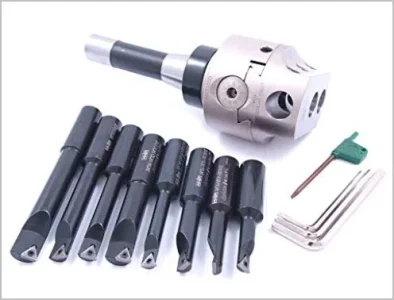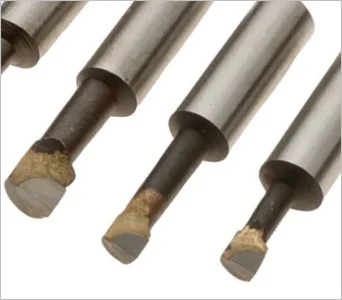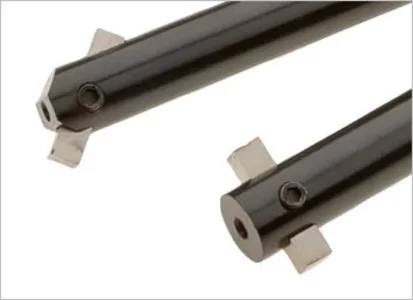-
Scam Alert. Members are reminded to NOT send money to buy anything. Don't buy things remote and have it shipped - go get it yourself, pay in person, and take your equipment with you. Scammers have burned people on this forum. Urgency, secrecy, excuses, selling for friend, newish members, FUD, are RED FLAGS. A video conference call is not adequate assurance. Face to face interactions are required. Please report suspicions to the forum admins. Stay Safe - anyone can get scammed.
You are using an out of date browser. It may not display this or other websites correctly.
You should upgrade or use an alternative browser.
You should upgrade or use an alternative browser.
Boring Head recommendations
- Thread starter Doggggboy
- Start date
Dabbler
ersatz engineer
@Doggggboy I bought a offshore 3" boring head, as it is big, more or less rigid, and CHEAP. If I wanted precision, I'd buy a Wolhaupter, but I'm not rich. (I got mine a Busy Bee on sale)
Dabbler
ersatz engineer
I'm not impressed with the one I got from BB. If I was to do it again, I think I'd be looking at KBC.
What, in particular, made it unimpressive?
What, in particular, made it unimpressive?
The amount of backlash in it. The little SOBA RT I had for my mini-mill had excessive backlash that you couldn't tune out of it as well.
Last edited:
Tom Kitta
Ultra Member
I have a small BH that is like busy bee stuff - similar to this - https://www.aliexpress.com/item/100...67-4&pdp_ext_f={"sku_id":"12000026336953316"}
in addition to many bigger ones. Cheap stuff - 50 bucks at most less then half the price of similar (same?) BH at Busy Bee.
it works fine within its size limitation. I.e. its not "heavy duty" or anything like that.
Besides for $50 CAD or less it is not to be expected to be "great" or "superior" product - but within its limits and given the price its not bad - at least it is a good start & better then nothing.
in addition to many bigger ones. Cheap stuff - 50 bucks at most less then half the price of similar (same?) BH at Busy Bee.
it works fine within its size limitation. I.e. its not "heavy duty" or anything like that.
Besides for $50 CAD or less it is not to be expected to be "great" or "superior" product - but within its limits and given the price its not bad - at least it is a good start & better then nothing.
I have a Criterion boring head that works very well.
The correct tooling makes a huge difference no matter what boring head.
If you're a member of Hobby Machinist there's an excellent treatise on boring: https://www.hobby-machinist.com/threads/a-boring-primer.75721/
The correct tooling makes a huge difference no matter what boring head.
If you're a member of Hobby Machinist there's an excellent treatise on boring: https://www.hobby-machinist.com/threads/a-boring-primer.75721/
I only jumped on the Criterion because it was <$100 CDN delivered@David_R8 I agree that it is best to buy as good a quality as you can afford, up to the actual need. I've only ever bored to the nearest half thou, and the BB one does that just fine.
I still dream of owning a Wohaupter, but perhaps in another life.
I have a generic import 2" boring head that uses 1/2" boring bars. It came from Busy Bee. The dovetail ways on it are nice and tight and I really can't see how it could be improved as the measuring graduations are dead accurate. Not pretty but it works well.



I have an Accusize 3" w 1/2" bars rebrand that had an MT3 taper on it. I just got an R8 arbor for it on Amazon. It fits fine and seems to work quite well. I have not tried to see what it will do if pushed yet.
It has locks on the V-Way.
It has locks on the V-Way.
You might also want to consider sets that include insert boring bars with inserts. Sometimes the cost isn't much more than the head. Just be aware the shanks come in different sizes & metric is becoming more prevalent in offshore offerings. Some bars may not be practical gradations or limited in bore sizes depending on the work you do. My experience with the cheapo braze-on carbide has not been good, maybe just unlucky. The geometry was hopelessly messed up, requiring diamond wheel to remedy. I like inserts because the geometry is set & many inexpensive flavors to choose from. I've also made my own from regular lathe boring bars. Bars that hold square HSS blanks can be very useful too for custom profile shapes.
Attachments
After reading @PeterT's post on bars for his boring head, I found myself curious about proper setup of my heads. What boring I have done has mostly worked out for me by virtue of translating my lathe boring experience into the equivalent milling operation.
But let's be serious, all my milling experience rolled up together amounts to squatt. An old drill press with an x/y table is just painful torture with no real skill development, and my mill/drill worked much better but it spent so long with no practical Z-axis that it never did get used for boring.
Recognizing that, I decided to see if I've been doing anything wrong. My very first search bagged one error,...... I think..... Here is a quote:
"The gib tension has been preset at the factory. The two gib screws should not be loosened to make size adjustments. These screws are for adjusting the gib pressure only and are filled with red wax to prevent accidental adjustment. The locking screw is the only screw used for making size changes to the boring head."
Really? I have always tightened them in use. Maybe that's what @Dabbler was referring to when he mentioned backlash. When I read that, I did a " huh? What backlash? " and then immediately dismissed it because "my heads all have locks" ..... Or do they?
Have I been doing this wrong? And if so, how do I correctly adjust the Gibb tension on my boring heads?
One more question for now. (I'm sure I'll have more as I learn more.) My bar sets all have 12 bits. Is that really necessary? Can't I get say half that number of indexable bits for the head and call it done? In fact, why not just three each. Three big ones for the big head and three little ones for the small head?
But let's be serious, all my milling experience rolled up together amounts to squatt. An old drill press with an x/y table is just painful torture with no real skill development, and my mill/drill worked much better but it spent so long with no practical Z-axis that it never did get used for boring.
Recognizing that, I decided to see if I've been doing anything wrong. My very first search bagged one error,...... I think..... Here is a quote:
"The gib tension has been preset at the factory. The two gib screws should not be loosened to make size adjustments. These screws are for adjusting the gib pressure only and are filled with red wax to prevent accidental adjustment. The locking screw is the only screw used for making size changes to the boring head."
Really? I have always tightened them in use. Maybe that's what @Dabbler was referring to when he mentioned backlash. When I read that, I did a " huh? What backlash? " and then immediately dismissed it because "my heads all have locks" ..... Or do they?
Have I been doing this wrong? And if so, how do I correctly adjust the Gibb tension on my boring heads?
One more question for now. (I'm sure I'll have more as I learn more.) My bar sets all have 12 bits. Is that really necessary? Can't I get say half that number of indexable bits for the head and call it done? In fact, why not just three each. Three big ones for the big head and three little ones for the small head?
Chip Maker
Super User
After reading @PeterT's post on bars for his boring head, I found myself curious about proper setup of my heads. What boring I have done has mostly worked out for me by virtue of translating my lathe boring experience into the equivalent milling operation.
But let's be serious, all my milling experience rolled up together amounts to squatt. An old drill press with an x/y table is just painful torture with no real skill development, and my mill/drill worked much better but it spent so long with no practical Z-axis that it never did get used for boring.
Recognizing that, I decided to see if I've been doing anything wrong. My very first search bagged one error,...... I think..... Here is a quote:
"The gib tension has been preset at the factory. The two gib screws should not be loosened to make size adjustments. These screws are for adjusting the gib pressure only and are filled with red wax to prevent accidental adjustment. The locking screw is the only screw used for making size changes to the boring head."
Really? I have always tightened them in use. Maybe that's what @Dabbler was referring to when he mentioned backlash. When I read that, I did a " huh? What backlash? " and then immediately dismissed it because "my heads all have locks" ..... Or do they?
Have I been doing this wrong? And if so, how do I correctly adjust the Gibb tension on my boring heads?
One more question for now. (I'm sure I'll have more as I learn more.) My bar sets all have 12 bits. Is that really necessary? Can't I get say half that number of indexable bits for the head and call it done? In fact, why not just three each. Three big ones for the big head and three little ones for the small head?
I think what Dabbler meant by backlash would be the amount of play when reversing direction with the adjustment dial.
I have a KBC boring head https://www.kbctools.ca/itemdetail/1-800-922B which is decent for the money. I always loosen and tighten the gib screws as I have with every boring head I've used in any shop with the exception of facing heads.
As for boring bar sets, the general rule of thumb I believe for boring bars is to use the shortest, largest bar you can to increase rigidity and decrease deflection.
I think what Dabbler meant by backlash would be the amount of play when reversing direction with the adjustment dial.
I have a KBC boring head https://www.kbctools.ca/itemdetail/1-800-922B which is decent for the money. I always loosen and tighten the gib screws as I have with every boring head I've used in any shop with the exception of facing heads.
As for boring bar sets, the general rule of thumb I believe for boring bars is to use the shortest, largest bar you can to increase rigidity and decrease deflection.
Well, at least I'm not the only one who tightens the gibbs every time I use it. I guess I reasoned that they are not really gibbs in the normal sense of the word. Just v-ways. Locking them just seemed to make obvious sense to me.
Your description of backlash is exactly how I would have described it. My comment about @Dabbler 's mention of backlash was just a reflection of my thinking that "who cares?" if you lock the travel by tightening the v-ways, backlash doesn't matter. I ALWAYS tighten all adjustable movement into the work not away from it. But.... If the gibbs are not supposed to be locked, then that thinking goes out the window!
I agree with your advice on which bar to use. Rigidity is almost always your friend. I just don't see the point of buying so many bars. Too much money. Better to use small bars with small heads and big bars with big ones and always use the biggest diameter and shortest length that works for the job. Other than really deep holes I can't see the point of buying big bars for a little head or vice versa. Maybe there is the odd application out there but I can't think of one off the top of my head.
Boring heads can have different adjustment procedures as a function of their design. Some have a simple split which the screws act upon & thus clamping the vee. Presumably would make no difference if you tightened them all. Others have something analogous to a gib strip and/or other clamping configurations, so best read the instructions. I'm pretty sure the BH's which can self-feed to prescribed diameter (Wohlhaupters & similar) require dovetail drag to be preset & would for sure have specific dedicated screws. **edit, I think that is what Chip Maker is calling facing head **
Here is older version of Wohlhaupter BH, but other automatic BH's may have different layout of screws & locks that perform similar functions.
Here is older version of Wohlhaupter BH, but other automatic BH's may have different layout of screws & locks that perform similar functions.
Last edited:



